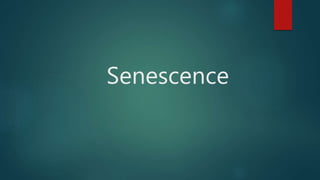
Cell senescence
- 1. Senescence
- 2. Aging Aging can be defined as the time-related deterioration of the physiological functions necessary for survival and fertility. The aging process has two major facets . The first is simply how long an organism lives; the second concerns the physiological deterioration, or senescence, that characterizes old age.
- 3. THEORIES OF AGING Traditionally aging was explained two theories Programmed theories imply that aging is regulated by biological clocks operating throughout the life span. This regulation would depend on changes in gene expression that affect the systems responsible for maintenance, repair and defense responses. Stochastic theories blame environmental impacts on living organisms that induce cumulative damage at various levels as the cause of aging, examples which range from damage to deoxyribonucleic acid (DNA), damage to tissues and cells by oxygen radicals (free radicals), and cross-linking.
- 4. Other theories Molecular Gene Theory Codon restriction Somatic mutation Gene regulation Cellular theory Free radical theory Wear and tear theory Apoptosis Senescence System theory Rate of living theory Neuro endocrine theory Immunologic theory Evolutionary theory Disposable soma Antagonistic pleiotropy Mutation accumulation
- 5. WHAT IS SENESCENCE ? The process by which a cell loses its ability to divide, grow, and function. This loss of function ultimately ends in death. In terms of cancer, it is the response of normal cells to potentially cancer-causing events. It is a strictly degenerative process and has no positive features. It is characterized by the declining ability to respond to stress, increasing homeostatic imbalance and increased risk of aging-associated diseases. Senescent cells secrete many inflammatory cytokines (e.g., IL6, IL8), growth factors (e.g., PDGF), proteases (e.g., MMPs)
- 6. The Hayflick’s paradigm Hayflick limit or Hayflick phenomenon is the number of times a normal human cell population will divide until cell division stops.
- 7. Factors responsible for senescence
- 8. Senescent cells: Many characteristics change Irreversible Growth Arrest Resistance to Apoptosis Altered Function/Gene Expression
- 9. Senescent Cells Accumulate In Vivo With Increasing Age, skin, retina, liver, spleen, aorta, kidney, etc. Venous ulcers Atherosclerotic plaques Arthritic joints Benign prostatic hyperplasia Pre-neoplastic lesions
- 10. Genes Responsible for Senescence Klotho gene : responsible for down regulation of insulin signaling and causes progeria. p53 : important regulator of cell division, stops cell cycle causing cell senescence, provides protection against cancer, “guardian of the genome”. sirtuin gene : encode histone deacetylation enzymes and blocks chromosomal rearrangement, sirtuin proteins prevent aging.
- 11. According to the GenAge database of aging-related genes there are over 700 genes associated with aging in model organisms
- 12. Senescence morphology Senescent cells become flattened, enlarged and have increased β-galactosidase activity Increased size of nucleus and nucleoli Increased number of multinucleated cells Increased number of lysosomes, Golgi and cytoplasmic microfilaments 'Young' Pre-senescent 'Aged' Senescent
- 13. Markers of a senescent cell p16 expression Heterochromatic foci damage Telomeric-DNA damage DNA damage foci Human skin, stained for SA-Bgal Dimri et al., Proc Natl Acad Sci USA, 1995
- 14. Senescence and insulin signaling cascade
- 15. Telomers and Senescence Telomere shortening causes cell senescence Somatic cells usually lack telomerase activity, which means that telomeres shorten with each cell division. cells may go into crisis as the result of reaching zero telomere length. Reactivation of telomerase enables cells to survive crisis and to become immortal. Eroded telomeres generate a persistent DNA damage response (DDR), which initiates and maintains the senescence growth arrest . This in turn activates the p53/p21 pathway.
- 17. Telomeres shorten with age (Harley, 1990)
- 18. In most somatic tissues, telomerase is expressed at very low levels or not at all -- as cells divide, telomeres shorten Short telomeres signal cells to senesce (stop dividing)
- 19. Oxidative stress and Senescence Oxidative metabolism produces highly reactive free radicals that subsequently damage protein and DNA. Oxygen free radicals generated cause cumulative oxidative damage, resulting in structural degeneration, apoptosis, functional decline, and age-related diseases. Evidence from model organisms Superoxide dismutase (SOD) transgenes can extend the life span of Drosophila. peroxidase activity can extend C. elegans life span. Catalase activity increases lifespan of C. elegans
- 21. Cell senescence and cancer Cellular senescence is an important tumour suppressor mechanism. The senescence response may be an example of evolutionary antagonistic pleiotropy. The rationale for antagonistic pleiotropy rests on the fact that most organisms evolve in environments that are replete with fatal extrinsic hazards. The age-related increase in senescent cells occurs in mitotically competent tissues, which, of course, are those that give rise to cancer
- 22. Short/dysfunctional telomeres (REPLICATIVE SENESCENCE) DNA Damage Oncogenes Chromatin Instability Supraphysiological Mitogenic/ Stress Signals Cellular Senescence Induced by Many (Cancer-Causing) Stimuli Irreversible arrest of cell proliferation
- 23. Inactivation of tumor suppressor genes encoding- p53 and pRB proteins = most common. p53 and pRB proteins – control expression of other genes, halt cell cycle progression in response to inducers of senescence, respond to senescent signals, allow normal cells to sense Mutations that dampen cellular senescence greatly increase susceptibility to cancer
- 24. The presence of telomerase in cancer cells allows them to maintain telomere length while they proliferate
- 26. Progeria Progeria is a premature aging syndrome in humans that appears to be caused by mutations in DNA repair enzyme In humans, Hutchinson-Gilford progeria is a rapid-aging syndrome; children born with this condition age rapidly, dying (usually of heart failure) as early as 12 years of age. Hutchinson-Gilford progeria is the result of a dominant mutation in the gene that encodes lamin A, a nuclear membrane protein, and these same mutations can be seen in age-related senescence p53 can be activated by the absence of lamin A, thereby suggesting a mechanism for Hutchinson-Gifford progeria
- 27. Symptoms All symptoms are the characteristics of the human senescent phenotype. skin with age spots, resorbed bone mass, hair loss, and arteriosclerosis
